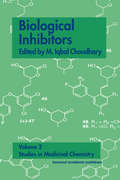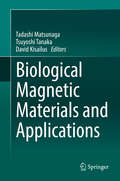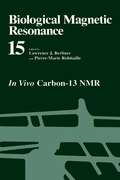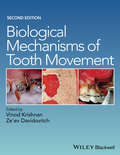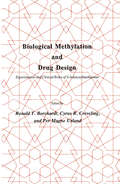- Table View
- List View
Biological Flows
by Colin G. Caro M. Y. JaffrinBiomechanics has a distinguished history extending at least to the 16th Century. However the later half oftbis century has seen an explosion ofthe field with it being viewed as affering exciting challenges for physical scientists and engineers interested in the life sciences, and wonderful opportunities for life scientists eager to collaborate with physical scientists and engineers and to render their scientific work more fundamental. That the field is now weil established and expanding is demonstrated by the formation of a World Committee for Biomechanics and the success and large participation in the 1st and 2nd World Congresses of Biomechanics, held respectively in San Diego in 1990 and in Amsterdam in 1994. With more than 1350 scientific papers delivered at the 2nd World Congress, either within symposia or oral or poster sessions, it would have been out of the question to try to produce comprehensive edited proceedings. Moreover, we are confident that most of the papers have been or will be published in one ofthe excellentjoumals covering the field. But of effort contributed by the plenary lecturers and the tutorial we thought that the large amount and keynote speakers of various symposia deserved tobe recognised in the form of a specific publication, thus also allowing those unable to attend the presentatiops . . tC\ sh?r~ in the findings. Furthermore, we feel that there is now a need to review aspects 'oftlie freld.
Biological Imaging and Sensing (Biological and Medical Physics, Biomedical Engineering)
by Toshiyuki FurukawaAn excellent survey of and introduction to new methods of biological imaging and sensing, particularly related to biomedical measurements and controls. The main topics discussed include: cell imaging, multiphoton microscopy for biomedical studies, molecular imaging, infrared imaging, biomedical magnetic imaging, and microscopy with laser-trapped particles. The book also deals with nanosurgery with light, the effects of ultrasound on tissue, diagnostics, near- and far-infrared transmission of biomedical information, and cell sensors. This book will be a valuable resource for both medical doctors and biophysicists.
Biological Influences on Criminal Behavior
by Gail AndersonBiological Influences on Criminal Behavior, Second Edition is fully updated to include recent research, studies, and publications examining the integration of the biological view with mainstream social, psychological, and environmental views in influences in criminality and criminal behavior. The first edition of the book was written with the belief, grounded in research, that something vital can be discovered when we assess all the factors related to the causes of crime, including biology. Since the first edition published, it has become broadly accepted that biology is certainly a factor in criminal behavior, albeit a singular piece to the puzzle. Increased collaborations between scientists and criminologists has led to a much stronger understanding of the intricacies of biology’s role in behavior. As well, more criminologists have biological backgrounds. As the science involved became more complex, so too did this text. This second edition considers the more recent and integrated research that is being conducted today to show the interaction between the environment and a person’s biology that lead to our behavior. It has even been shown that the environment acts on, and actually changes the functions, of some genes. The book begins with basic scientific principles and advances to introduce the reader to the more in-depth discussions of various biological influencers. Biological Influences on Criminal Behavior, Second Edition is written primarily for social science and law students who wish to understand this exciting area. The book offers a greater understanding of this rapidly growing field so that its lessons can help to inform policy, treatments, rehabilitation and the law.
Biological Influences on Criminal Behavior
by Gail AndersonBiological Influences on Criminal Behavior, Second Edition is fully updated to include recent research, studies, and publications examining the integration of the biological view with mainstream social, psychological, and environmental views in influences in criminality and criminal behavior. The first edition of the book was written with the belief, grounded in research, that something vital can be discovered when we assess all the factors related to the causes of crime, including biology. Since the first edition published, it has become broadly accepted that biology is certainly a factor in criminal behavior, albeit a singular piece to the puzzle. Increased collaborations between scientists and criminologists has led to a much stronger understanding of the intricacies of biology’s role in behavior. As well, more criminologists have biological backgrounds. As the science involved became more complex, so too did this text. This second edition considers the more recent and integrated research that is being conducted today to show the interaction between the environment and a person’s biology that lead to our behavior. It has even been shown that the environment acts on, and actually changes the functions, of some genes. The book begins with basic scientific principles and advances to introduce the reader to the more in-depth discussions of various biological influencers. Biological Influences on Criminal Behavior, Second Edition is written primarily for social science and law students who wish to understand this exciting area. The book offers a greater understanding of this rapidly growing field so that its lessons can help to inform policy, treatments, rehabilitation and the law.
Biological Inhibitors
by M. Iqbal ChoudharyThis book, a part of the series Studies in Medicinal Chemistry, details the biological inhibitors that reflect drug discovery in treating human diseases, including cardiovascular, nervous, inflammatory, hormonal and metabolic processes. Compounds for fungal diseases and HIV/AIDS are also covered.
Biological Inhibitors
by M. Iqbal ChoudharyThis book, a part of the series Studies in Medicinal Chemistry, details the biological inhibitors that reflect drug discovery in treating human diseases, including cardiovascular, nervous, inflammatory, hormonal and metabolic processes. Compounds for fungal diseases and HIV/AIDS are also covered.
Biological Magnetic Materials and Applications
by Tadashi Matsunaga Tsuyoshi Tanaka David KisailusThis book addresses the biologically controlled synthesis of magnetic materials, and its applications in bio-inspired design and synthesis. It highlights several key aspects of biologically produced magnetic materials – (i) organisms that biologically synthesize and utilize magnetic materials; (ii) formation mechanisms; (iii) how these biological formation routes yield various phases and morphologies; and (iv) the resultant magnetic and structural properties – and describes diverse bio-inspired approaches to utilizing magnetic materials in applications ranging from semiconductor to health industries.In addition, the book discusses the recent industrial use of magnetic materials to develop scalable technologies that encompass protein displays, drug-delivery, biophysical separations, and medical diagnostics, as well as outlining future next-generation applications. As such, it offers valuable insights for all scientists interested in using multidisciplinary fields to overcome current obstacles, and in gaining multifaceted expertise in magnetic materials bionanotechnology.
Biological Magnetic Resonance: Volume 2 (Biological Magnetic Resonance #2)
by Lawrence J. BerlinerWe are pleased to present this second volume of a series that has already received much interest. The application of magnetic resonance methods to the study of actual biological systems as contrasted to cell-free samples, although not entirely novel, as demonstrated by Civan and Shporer in Volume I, has taken on new dimensions with the use of phosphorus-31 and carbon-13 NMR in studying cells, tissues, and organelles. The applications of 31 P NMR to such systems is reviewed in this volume, while carbon-13 will be covered in a later one. The use of nitroxide spin labels has grown to the point where it now may be considered a common biological technique. The synthesis and applications of a new class of nitroxides is described in this volume. ESR spectroscopy of paramagnetic ions is a powerful approach to studying molecular and structural details, as the chapter by Boas, Pilbrow, and Smith on the ESR of copper in Volume 1 has shown. In this volume the ESR of molybdenum and iron is treated in a comparable fashion. In the first volume some aspects of 1 H NMR spectroscopy of certain classes of In this volume the high-resolu biological macromolecules were discussed.· tion multinuclear NMR spectra of peptides, including the physiologically significant peptide hormones, are reviewed.
Biological Magnetic Resonance: In Vivo Carbon-13 NMR (Biological Magnetic Resonance #15)
by Lawrence J. Berliner Pierre-Marie RobitailleThis volume constitutes a compilation of the latest experiments and theories on a rapidly evolving and maturing field in MRI/MRS, which is the use of the stable isotope 13-C. The 13-C is used to probe the chemistry, mechanism, and function in living systems. All the chapters are written by experts in the field who discuss topics such as `Tracer Theory and the Suitability of 13-C NMR', `Applications of 13-C to Studies of Human Brain Metabolism', etc.
Biological Markers in Psychiatry and Neurology: Proceedings of a Conference Held at the Ochsner Clinic, New Orleans, on May 8-10, 1981
by Israel Hanin Earl UsdinBiological Markers in Psychiatry and Neurology is a collection of papers that details the advancement in the understanding of the biological markers that stems from psychiatric and neurological pathologies. The text first covers topics about various biological markers, such as neurochemical, enzymatic, membrane, receptors, endocrine, and physiological. Next, the selection examines the relationship between alcohol abuse and biological papers. The next part covers the genetic aspects of biological markers. The text also deals with use of tomography and modeling theory. The book will be of great use to students, researchers, and practitioners of neurology and psychiatry. Psychologists will also benefit from the text.
Biological Markers of Alzheimer’s Disease (Research and Perspectives in Alzheimer's Disease)
by François Boller Robert Katzman Andre Rascol Jean-Louis SignoretThis volume presents the proceedings of the symposium held in Toulouse on April 24, 1989, on the topic "Biological Markers of Alzheimer's Disease. " This sym posium was the fourth of a continuing and successful series of Colloques Medecine et Recherche organized by the Fondation IPSEN pour la Recherche Therapeutique, addressing various aspects of contemporary research in the field of Alzheimer's disease (AD). The series started in September 1987 with "Im munology and Alzheimer's Disease," followed 6 months later in Paris by "Gene tics and Alzheimer's Disease" and in September 1988 in Montpellier by "Neuronal Grafting and Alzheimer's Disease. " The present symposium was organized for the purpose of gathering the most current ideas concerning biological markers of AD. The papers presented at this symposium may be roughly subdivided into three groups. The first deals with the markers of AD at the level of the brain itself. These markers are studied either through the cerebrospinal fluid or through techniques such as nuclear magnetic resonance (NMR) - approaches which respectively aim at demonstrating the cerebral changes indicated by the debris resulting from the disease, or studying the possible neurochemical abnormalities that occur in the earlier stages of AD.
Biological Matrices and Tissue Reconstruction
by G. B. Stark R. Horch E. TánczosC.A. VACANTI The loss or failure of an organ or tissue is one of the most frequent, devastating, and costly problems in human health care. Advances in the medical sciences have enabled physicians to restore lost functions in their patients through or gan transplantation, reconstructive surgery with autogenous tissue transfer, or the implantation of alloplastic materials. Although only recently termed "Tissue Engineering" [1], the use of biological andlor synthetic materials in conjunction with cells to create biologic substitutes to serve as functional tis sue replacements has been explored by modern scientists for several decades. The concept of generating functional tissue from an organ biopsy was de scribed very early in the literature: "The Lord God cast a deep sleep on the man, and while he was asleep, he took out one of his ribs and closed up its place with flesh. The Lord God then built up into a woman the rib that he had taken from the man" [2]. Review of history further reveals that, according to legend, the first homotransplantation of an entire limb was performed by Saints Damian and Cosmas, as depicted by the artist Fra Angelico.
Biological Mechanisms of Minimal Residual Disease and Systemic Cancer
by Julio A. Aguirre-GhisoThis book focuses on the biological mechanisms of minimal residual disease (MRD) and recurrence. It integrates this biology in solid cancers and in hematological malignancies. It reports also on technological advancements for monitoring MRD, derived from mechanistic insights. Chapters in solid and hematological malignancies address stem cell biology, genetics, epigenetics and micro-environmental regulation of dormant MRD. Novel insight into technologies for molecular phenotyping of MRD and monitoring of CTCs, DTCs and cell free RNA and DNA are also addressed extensively. Five chapters explore the above concepts in solid cancers such as prostate, breast, melanoma, head and neck and esophageal. Two chapters also explore the basic mechanisms of vascular biology targeting and epigenetic mechanisms regulating pluripotency programs during dormancy. Similar biology is explored in hematological malignancies such as T-ALL, CML, AML and multiple myeloma in additional four chapters. This book is edited and prefaced by Dr. Julio Aguirre-Ghiso, an expert in dormancy and recurrence. The chapters are written by world-recognized experts Drs. Ravi Bahtia, Samir Parekh, Russel Taichman, Monica Guzman, David Hoon, Denis Schewe, Irmela Jeremias, Cyrus Ghajar, Maria Soledad Sosa and Nicholas Stoecklein. The topic of this book is of particular interest to both basic cancer cell biologists and physician scientists that are working to provide a more integrated view of the biology of MRD and to those interested in working on or learning about this paradigm. The integrated and cross-disciplinary focus of the book from biology to medicine seeks to help bridge gaps to improve cancer care and prevent recurrences.
Biological Mechanisms of Tooth Movement
by Vinod Krishnan Anne Marie Kuijpers?Jagtman Ze Ev DavidovitchThis new edition continues to be an authoritative reference to the scientific foundations underpinning clinical orthodontics The newly and thoroughly revised Third Edition of Biological Mechanisms of Tooth Movement delivers a comprehensive reference for orthodontic trainees and specialists. It is fully updated to include new chapters on personalized orthodontics as well as the inflammatory process occurring in the dental and paradental tissues. It is heavily illustrated throughout, making it easier for readers to understand and retain the information discussed within. The topics covered range from bone biology, the effects of mechanical loading on tissues and cells, genetics, tissue remodeling, and the effects of diet, drugs, and systemic diseases. The Third Edition of Biological Mechanisms of Tooth Movement features seven sections that cover subjects such as: The development of biological concepts in orthodontics, including the cellular and molecular biology behind orthodontic tooth movement Mechanics meets biology, including the effects of mechanical loading on hard and soft tissues and cells, and biological reactions to temporary anchorage devices Inflammation and orthodontics, including markers for tissue remodeling in the gingival crevicular fluid and saliva Personalized diagnosis and treatment based on genomic criteria, including the genetic influences on orthodontic tooth movement Rapid orthodontics, including methods to accelerate or decelerate orthodontic tooth movement Perfect for residents and PhD students of orthodontic and periodontal programs, Biological Mechanisms of Tooth Movement is also useful to academics, clinicians, bone biologists, and researchers with an interest in the mechanics and biology of tooth movement.
Biological Mechanisms of Tooth Movement
by Vinod Krishnan Anne Marie Kuijpers-Jagtman Zeev DavidovitchThis new edition continues to be an authoritative reference to the scientific foundations underpinning clinical orthodontics The newly and thoroughly revised Third Edition of Biological Mechanisms of Tooth Movement delivers a comprehensive reference for orthodontic trainees and specialists. It is fully updated to include new chapters on personalized orthodontics as well as the inflammatory process occurring in the dental and paradental tissues. It is heavily illustrated throughout, making it easier for readers to understand and retain the information discussed within. The topics covered range from bone biology, the effects of mechanical loading on tissues and cells, genetics, tissue remodeling, and the effects of diet, drugs, and systemic diseases. The Third Edition of Biological Mechanisms of Tooth Movement features seven sections that cover subjects such as: The development of biological concepts in orthodontics, including the cellular and molecular biology behind orthodontic tooth movement Mechanics meets biology, including the effects of mechanical loading on hard and soft tissues and cells, and biological reactions to temporary anchorage devices Inflammation and orthodontics, including markers for tissue remodeling in the gingival crevicular fluid and saliva Personalized diagnosis and treatment based on genomic criteria, including the genetic influences on orthodontic tooth movement Rapid orthodontics, including methods to accelerate or decelerate orthodontic tooth movement Perfect for residents and PhD students of orthodontic and periodontal programs, Biological Mechanisms of Tooth Movement is also useful to academics, clinicians, bone biologists, and researchers with an interest in the mechanics and biology of tooth movement.
Biological Mechanisms of Tooth Movement
by Vinod Krishnan Ze’ev DavidovitchBiological Mechanisms of Tooth Movement, Second Edition is an authoritative reference to the scientific foundations underpinning clinical orthodontics. Led by an expert editor team and with contributions from an international group of contributors, the book covers key topics including bone biology, the effects of mechanical loading on tissues and cells, genetics, inflammation, tissue remodeling and the effects of diet, drugs, and systemic diseases. Highly-illustrated throughout, this second edition has been fully revised, updated and expanded to new developments in genomics, rapid orthodontics and current controversies in tooth movement research. Trainees, qualified specialists and researchers in orthodontics can rely on this comprehensive text to inform them about the clinical and scientific implications of the biological mechanisms involved in the movement of teeth.
Biological Mechanisms of Tooth Movement
by Vinod Krishnan Zeev DavidovitchBiological Mechanisms of Tooth Movement, Second Edition is an authoritative reference to the scientific foundations underpinning clinical orthodontics. Led by an expert editor team and with contributions from an international group of contributors, the book covers key topics including bone biology, the effects of mechanical loading on tissues and cells, genetics, inflammation, tissue remodeling and the effects of diet, drugs, and systemic diseases. Highly-illustrated throughout, this second edition has been fully revised, updated and expanded to new developments in genomics, rapid orthodontics and current controversies in tooth movement research. Trainees, qualified specialists and researchers in orthodontics can rely on this comprehensive text to inform them about the clinical and scientific implications of the biological mechanisms involved in the movement of teeth.
Biological Membrane Ion Channels: Dynamics, Structure, and Applications (Biological and Medical Physics, Biomedical Engineering)
by Shin-Ho Chung Olaf S. Anderson Vikram V. KrishnamurthyThis book deals with recent breakthroughs in ion-channel research that have been brought about by the combined effort of experimental biophysicists and computational physicists, who together are beginning to unravel the story of these exquisitely designed biomolecules. With chapters by leading experts, the book is aimed at researchers in nanodevices and biosensors, as well as advanced undergraduate and graduate students in biology and the physical sciences.
Biological Membranes: A Molecular Perspective from Computation and Experiment
by Kenneth M. Merz Benoit RouxThe interface between a living cell and the surrounding world plays a critical role in numerous complex biological processes. Sperm/egg fusion, virus/cell fusion, exocytosis, endocytosis, and ion permeation are a few examples of processes involving membranes. In recent years, powerful tools such as X-ray crystal lography, electron microscopy, nuclear magnetic resonance, and infra-red and Raman spectroscopy have been developed to characterize the structure and dy namics of biomembranes. Despite this progress, many of the factors responsible for the function of biomembranes are still not well understood. The membrane is a very complicated supramolecular liquid-crystalline structure that is largely composed of lipids, forming a bilayer, to which proteins and other biomolecules are anchored. Often, the lipid bilayer environment is pictured as a hydropho bic structureless slab providing a thermodynamic driving force to partition the amino acids of a membrane protein according to their solubility. However, much of the molecular complexity of the phospholipid bilayer environment is ignored in such a simplified view. It is likely that the atomic details of the polar head group region and the transition from the bulk water to the hydrophobic core of the membrane are important. An understanding of the factors responsible for the function of biomembranes thus requires a better characterization at the molec ular level of how proteins interact with lipid molecules, of how lipids affect protein structure and of how lipid molecules might regulate protein function.
Biological Methylation and Drug Design: Experimental and Clinical Role of S-Adenosylmethionine (Experimental Biology and Medicine #12)
by Ronald T. Borchardt Cyrus R. Creveling Per Magne UelandThis book has been developed from its earlier and far less formal presentment as the proceedings of a symposium entitled The Biochemistry of S-Adenosylmethionine as a Basis for Drug Design that was held at the Solstrand Fjord Hotel in Bergen, Norway on June 30-July 4, 1985. The purpose of the symposium was to bring together scientists from various disciplines (biochemistry, pharmacology, virology, immunology, chemistry, medicine, and so on) to discuss the recent advances that have been made in our understanding of the biological roles of S adenosylmethionine (AdoMet) and to discuss the feasibility of utilizing AdoMet-dependent enzymes as targets for drug design. Thus the information provided herein will be of value not only to basic scientists involved in elucidating the role of AdoMet in biology, but also to medicinal chemists who are using this basic knowledge in the process of drug design. The volume should also be of interest to pharmacologists and clinicians involved in biological evaluation of potential therapeutic agents arising from the efforts of the biochemists and medicinal chemists. Each plenary speaker at the symposium was requested to submit a chapter reviewing recent contributions of their discipline to our base of knowledge about the biological role of AdoMet. Topics covered in this volume include protein and phospholipid methylations (Section A), nucleic acid methyl ations (Section B), the regulation of AdoMet, S-adenosylhomocysteine, and methylthioadenosine metabolism (Section C), clinical aspects of AdoMet (Section D), and the design, synthesis, and biological evaluation of trans methylation inhibitors (Section E).
Biological Micro- and Nanotribology: Nature’s Solutions (NanoScience and Technology)
by Matthias Scherge Stanislav S. GorbBy employing a combination of approaches from several disciplines the authors elucidate the principles of a variety of biomechanical systems that rely on frictional surfaces or adhesive secretions to attach parts of the body to one another or to attach organisms to a substrate. This account provides an excellent starting point for engineers and physicists working with biological systems and for biologists studying friction and adhesion. It will also serve as a valuable introduction for graduate students entering this interdisciplinary field of research.
Biological Microarrays: Methods and Protocols (Methods in Molecular Biology #671)
by Ali Khademhosseini, Kahp-Yang Suh and Mohammed ZourobRecent developments in microarray technology have changed the landscape of biology and biomedical research, and they have revolutionized RNA and DNA research. In Biological Microarrays: Methods and Protocols, expert researchers explore exciting new developments in the field, providing a comprehensive approach to biological microarrays that conveys not only the state-of-the-art fundamentals, but also includes applications of the most innovative methods. Chapters address both the application of biological microarrays, including DNA/RNA, apatmer, proteins, tissues, oligonucleotides, carbohydrates, biomaterials, cells, bacteria, and virus microarrays, and also explore the different techniques used for generating microarray platforms. Composed in the highly successful Methods in Molecular Biology™ series format, each chapter contains a brief introduction, step-by-step methods, a list of necessary materials, and a Notes section which shares tips on troubleshooting and avoiding known pitfalls. Wide-ranging and revolutionary, Biological Microarrays: Methods and Protocols serves as a primary source for academics, practitioners, and professionals in related fields, including biologists, biotechnologists, biochemists, analytical chemists, and biomedical, physical, and microsystems engineers, to name a few, appealing to all of those interested in the present and future state of biological microarray research.
The Biological Mind: How Brain, Body, and Environment Collaborate to Make Us Who We Are
by Alan JasanoffA pioneering neuroscientist argues that we are more than our brains To many, the brain is the seat of personal identity and autonomy. But the way we talk about the brain is often rooted more in mystical conceptions of the soul than in scientific fact. This blinds us to the physical realities of mental function. We ignore bodily influences on our psychology, from chemicals in the blood to bacteria in the gut, and overlook the ways that the environment affects our behavior, via factors varying from subconscious sights and sounds to the weather. As a result, we alternately overestimate our capacity for free will or equate brains to inorganic machines like computers. But a brain is neither a soul nor an electrical network: it is a bodily organ, and it cannot be separated from its surroundings. Our selves aren't just inside our heads -- they're spread throughout our bodies and beyond. Only once we come to terms with this can we grasp the true nature of our humanity.
Biological Models in Radiopharmaceutical Development (Developments in Nuclear Medicine #27)
by R.M. LambrechtRadiophannaceuticals labeled with short-lived radionuclides are utilized to unravel biochemical processes, and to diagnosis and treat diseases of the living body are-developed through extensive evaluation in ~iological models. 'fhC first attempt to compile information was a volume entitled ANIMAL MODELS IN RADIOTRACER DESIGN that was edited by William C. Eckelman and myself in 1983. The volume had a focus on the animal models that investigators were using in order to design radiotracers that displayed in vivo selectivity as measured by biodistribution and pharmacokinetic studies. A concern in the early days of nuclear medicine was species differences. Often a series of labeled compounds were evaluated in a several different animal models in order to gain confidence that the selected radiotracer would behave appropriately in humans. During the past 12 years there have been remarkable advances in molecular genetics, molecular biology, synthetic radiopharmaceutical chemistry, molecular modeling and visualization, and emission tomography. Biological models can now be selected that are better defined in terms of molecular aspects of the disease process. The development of high resolution PET and SPET for clinical applications facilitates the development of new radiopharmaceuticals by the use of models to quantitatively evaluate drug effects, and progression of disease, and hence to arrive at better diagnosis and treatments for animals and humans. With these advances there is an effective use of biological models, and the refinement of alternatives for the development of new radiophannaceuticals.
Biological Modulation of Solid Tumours by Interferons (ESO Monographs)
by Karl PummerIn the 1960s, it was reported that interferons have antitumour activity in different experimental models. Since that time, numerous studies have been performed to elucidate the various mechanisms of action that have been proposed. However, there is much controversy in the literature and promising preclinical findings failed to translate into substantial clinical progress. The present book gives a critical overview of current knowledge of how interferons act in solid tumours. For this purpose, after two chapters of general aspects of interferon action and interaction, selected solid tumours which are commonly considered difficult to treat in advanced stages are discussed with respect to both preclinical data and clinical experience.



